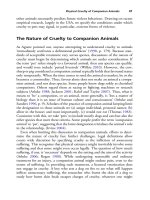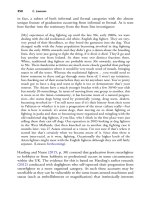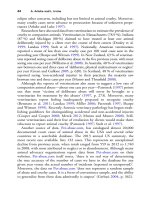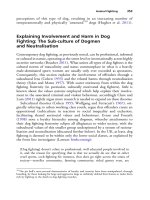The palgrave international handbook of a 154
Bạn đang xem bản rút gọn của tài liệu. Xem và tải ngay bản đầy đủ của tài liệu tại đây (25.76 KB, 1 trang )
Status Dogs
145
effectively banning and requiring state sanctioned destruction of certain
breeds. Control agencies (largely the media) have greatly influenced this
approach, heightening public concern and anxiety (Cohen and Richardson
2002). Under the banner of ‘protecting society’ the routine killing of healthy
dogs has become accepted and normalised, predicted and expected, guilt free
and victimless animal abuse. While many stray and abandoned dogs are
euthanised in the UK, there has been a significant increase in the number of
status-type dogs who have met this fate at the hands of the state or NGOs.
This response is consistent with other ‘exaggerated’ responses by control
agencies identified by Cohen (1985) and Schur (1963) in reaction to homosexuality, abortion and drugs use, which they argue have generated more
problems than were solved. These dogs are not inherently bad or dangerous,
rather, their natural, positive, physical and personality traits are construed to
be deviant: powerful becomes uncontrollable; confident becomes dominant;
energetic becomes dangerous; resilient becomes unstoppable. The stark
reality is that many status dogs are killed under the guise of being dangerous,
when it is their conformity to a breed standard (such as the pit bull terrier)
that seals their fate. The fact that existing dog behavioural literature and dog
bite statistics evidence that dangerous dog behaviour is neither exclusive to,
nor most prevalent in these breeds, is ignored or rebuked, even when
organisations like the British Veterinary Association do not support BSL
for these reasons. There is no scientific criterion yet identified to determine a
dog is dangerous simply by virtue of its genetic or other physical parameters.
As Humphreys et al. (2014, p. 5) confirm with regard to dog bites, ‘Breed is
not a good predictor of risk; other factors including the history of the dog,
socialisation and context of the event are important’.
In terms of secondary deviance, evidently dogs do not themselves construct a deviant identity and turn to criminality; their owners do this via
aggressive breeding and training. They shape a dog willing to protect and to
fight other dogs and other perceived threats, often exposing them to negative
welfare conditions, training and cruelty. To avoid rejection, these dogs learn
to fulfil the deviant and dangerous label their owner assigns them.
Social Reactions to Status Dogs
As discussed, the reaction and responses to the status dog phenomenon has
had serious consequences for dogs residing in the UK. Cultural developments, including society’s disregard for ‘dangerous’ dogs can be seen within
media reporting and imagery, while the path of legislation has been, and









